by Bruce Wells | Apr 26, 2025 | Petroleum Technology
A two-wicked safety lamp for preventing “destructive conflagrations” on oil derricks.
Oil patch lore says “Yellow Dog” lanterns got their name because of two burning wicks that resembled a dog’s glowing eyes at night. Others say the lamps cast an eerie dog’s head shadow on the derrick floor.
Rare is the community oil museum that doesn’t have a Yellow Dog in its collection. Officially patented a decade after the Civil War, the two-wicked “Derrick Safety Lamp” would become an oilfield icon. But long before Yellow Dogs found their way to the oil patch, a similar design burned animal fat atop America’s lighthouses.

First patented in 1870, Jonathan Dillen’s lantern was “adapted for use in the oil regions…where the explosion of a lamp is attended with great danger by causing destructive conflagration and consequent loss of life and property.”
By the late 1700s, the cylindrical “Bucket Lamp” included two or four spouts protruding from its sides, according to Thomas Tag in Lighthouse Lamps Through Time. “Each spout carried a large diameter rope wick that extended down inside the body of the lamp into the oil.”
As late as 1874, four years after the Yellow Dog lamp’s patent, the U.S. Lighthouse Board of the Department of Treasury continued to mandate the use of lard for fueling the beacons, later rejecting electricity and natural gas because of “the complexity and cost of the apparatus.”

By 1877, the Lighthouse Board changed its illumination mandate to kerosene, which would be supplanted by electric arc lamps and followed by incandescent bulbs.
Inventing the Yellow Dog
Despite its many oilfield service manufacturers, the Yellow Dog’s origins remain in the dark. Some historical sources claim the derrick lamp’s design originated with the whaling industry, but neither the Nantucket nor New Bedford whaling museums have found any such evidence.
Railroad museums often include collections of cast iron smudge pots, but nothing approaching the heavy, crude-oil-burning lanterns once prevalent in oilfields from Pennsylvania to California.
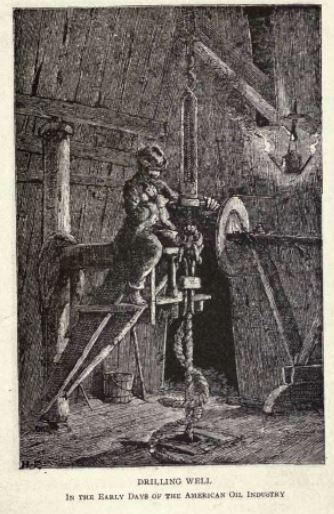
A 19th-century illustration of a cable-tool driller with his nearby Yellow Dog lantern.
Inventor Jonathan Dillen of Petroleum Centre, Pennsylvania, was first to patent what became the iconic lantern of the early years of the petroleum industry. His U.S. patent was awarded on May 3, 1870. The two-wicked lamp joined other safety innovations as drilling technologies evolved.
The lamp was designed “for illuminating places out of doors, especially in and about derricks, and machinery in the oil regions, whereby explosions are more dangerous and destructive to life and property than in most other places.”

“My improved lamp is intended to burn crude petroleum as it comes from the wells fresh and gassy,” Dillen proclaimed. “It is to be used, mainly, around oil wells, and its construction is such as to make it very strong, so that it cannot be easily broken or exploded.”
Dillen’s Yellow Dog patent was improved upon and reissued in 1872 and again in 1877 when it was assigned to a growing oilfield equipment supplier.
Oil Well Supply Company
In 1861, John Eaton made a business trip to the booming oil region of western Pennsylvania. Within a few years, he had set up his own business with Edward Cole. With the addition of Edward Burnham, the company grew to become a preeminent supplier of oilfield equipment.

A John Eaton biography by his great-grandson notes Eaton was considered “the father of the well supply trade” of early Pennsylvania oilfields.
By 1877, Eaton, Cole & Burnham oilfield supply had outlets in the Pennsylvania oil regions, including Pittsburgh and Bradford. The company changed its name Oil Well Supply Company the next year, according to a biography by his great-grandson, Louis B. Fleming.
“The first goods manufactured by the Oil Well Supply Company were made on a foot lathe,” John Eaton would recall. The oilfield equipment supply company was operating 75 manufacturing plants by the turn of the 20th century.

The biography, John Eaton, by journalist Fleming, cited the classic 1898 book Sketches in Crude Oil, which noted that Oil Well Supply company’s founder and president “may fairly claim to be the father of the well supply trade.”
A Pennsylvania Historical and Museum Commission roadside marker erected in Oil City in 1992 notes: “Oil Well Supply Company — Founded nearby in 1878, it was a leading manufacturer of oil well machinery and supplies, serving the oil industry across the globe. By the early 1900s, employment peaked at 2,000. In 1930 it became a subsidiary of United States Steel.”
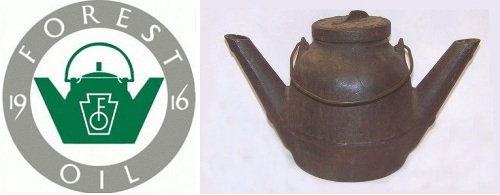
Incorporated in Pennsylvania — the Keystone State — Forest Oil’s logo features the iconic two-wicked lamp invented in 1870.
In Oil City at its 45-acre Imperial Works on the Allegheny River, Oil Well Supply manufactured oilfield engines and “cast and malleable iron goods” that included the two-wicked derrick safety lamp. The 1884 Oil Well Supply catalog listed Yellow Dog lamps at $1.50 each.
Today, along with their shadowy origins, the Yellow Dog lanterns are relegated to museums, antique shops and collectors. They sometimes can be found on display next to another unusual two-wicked lamp (see Camphene to Kerosene Lamps).
Forest Oil Company Logo
After experimenting with injecting water into some wells to increase production from others, Forest Dorn partnered with his father Clayton in 1916 to establish Forest Oil, an oilfield service company in Pennsylvania’s giant Bradford oilfield.
The company in February 1824 adopted the two-wicked oilfield derrick lamp as part of its logo, which included a keystone shape inside the lantern to symbolize the state of Pennsylvania — where the first commercial U.S. oil well was drilled in Titusville in 1859.

Forest Oil Company developed an extremely efficient technique for “secondary recovery” of trapped petroleum reservoirs. The waterflooding proved revolutionary for improving oilfield production nationwide. The technological leap began at America’s first giant oilfield, discovered in 1871 in Bradford, about 70 miles east of Titusville.
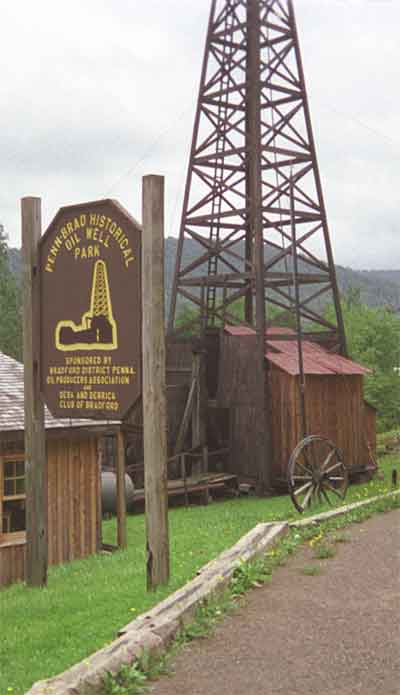
An oil museum near Bradford, Pennsylvania, educates visitors using a replica of an 1880s standard cable-tool derrick. Photo by Bruce Wells.
By 1916, oil production in the Bradford field had declined to just under 40 barrels a day. The reserve was considered by many to be dry — until Forest Dorn had applied his water-flooding technique to initiate secondary recovery of oil. Forest Oil became widely recognized as a leader in secondary oil recovery systems.
Water-flooding boosted oilfield production and arrived as demand for gasoline was growing (see Cantankerous Combustion – First U.S. Auto Show). The rapidly growing science of petroleum geology also led to more “secondary recovery” technologies.
Enhanced recovery would be applied throughout the petroleum industry, extending individual well production by 10 years — especially benefitting the already considerable production from the largest oilfield in the lower 48 states, the East Texas oilfield, discovered in 1930.
Oil Museums
The history of America’s “first billion-dollar oilfield” is on exhibit at the Penn-Brad Historical Oil Park and Museum near Bradford, Pennsylvania — where a modern natural gas shale boom has renewed the historic oil patch economy.

Located in Custer City, three miles south of Bradford (home of Zippo lighters), the museum (maintained by many dedicated volunteers) “preserves the philosophy, the spirit, and the accomplishments of an oil country community.”
One attraction of the Penn-Brad museum is its 72-foot standard cable-tool derrick and engine house, replicas of 1880s technology that helped Bradford once produce 74 percent of all U.S. oil. It’s another noteworthy stop among other excellent Pennsylvania oil museums a few hours west of Bradford at the Drake Well Museum in Titusville.
_______________________
Recommended Reading: Early Days of Oil: A Pictorial History of the Beginnings of the Industry in Pennsylvania (2000); Images of America: Around Bradford
(2000); Images of America: Around Bradford (1997); The Prize: The Epic Quest for Oil, Money & Power (1991). Your Amazon purchase benefits the American Oil & Gas Historical Society. As an Amazon Associate, AOGHS earns a commission from qualifying purchases.
(1997); The Prize: The Epic Quest for Oil, Money & Power (1991). Your Amazon purchase benefits the American Oil & Gas Historical Society. As an Amazon Associate, AOGHS earns a commission from qualifying purchases.
_______________________
The American Oil & Gas Historical Society (AOGHS) preserves U.S. petroleum history. Please become an AOGHS annual supporter and help maintain this energy education website and expand historical research. For more information, contact bawells@aoghs.org. © 2025 Bruce A. Wells. All rights reserved.
Citation Information – Article Title: “Yellow Dog – Oilfield Lantern.” Authors: B.A. Wells and K.L. Wells. Website Name: American Oil & Gas Historical Society. URL: https://aoghs.org/technology/yellow-dog-oil-field-lantern. Last Updated: April 22, 2025. Original Published Date: September 1, 2008.
by Bruce Wells | Sep 19, 2024 | Petroleum Pioneers
Pico Canyon oilfield brought pipelines, refineries and Chevron.
Following the 1859 first commercial U.S. oil discovery in Pennsylvania, the earliest petroleum exploration companies were attracted to California’s natural oil seeps. Small but promising discoveries after the Civil War led to the state’s first gusher in 1876 — and the launching of a new California industry.
Pico Canyon, less than 35 miles north of Los Angeles, produced limited amounts of oil as early as 1855, but there was no market for the petroleum found near natural oil seeps. The first California drilling boom arrived a decade later in the northern part of the state with an oilfield also found near seeps.
Humboldt County Oil
Completed in 1865 by the Old Union Matolle Oil Company, the Humboldt County well produced oil near the aptly named Petrolia. The oilfield discovery quickly attracted some of America’s earliest exploration companies.
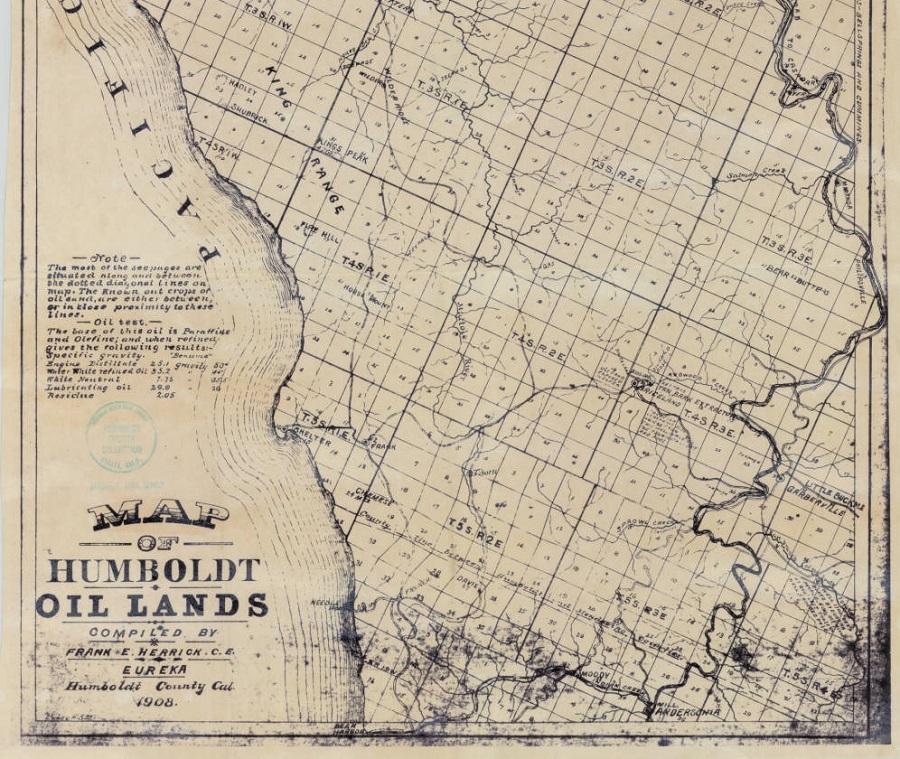
Detail of a 1908 “Map of Humboldt County Oil Lands” includes post-Civil War commercial oil wells that attracted more drilling to northern California. Map courtesy Humboldt County Map Collection, Cal Poly Humboldt Library Special Collection.
A California historical marker (no. 543) dedicated on November 10, 1955 declared:
California’s First Drilled Oil Wells — California’s first drilled oil wells producing crude to be refined and sold commercially were located on the north fork of the River approximately three miles east of here. The Old Union Mattole Oil Company made its first shipment of oil from here in June 1865 to a San Francisco refinery. Many old wellheads remain today.

Although the “Old Union well” initially yielded about 30 barrels of high-quality oil, production declined to one barrel of oil per day and the prospect was abandoned, according to K.R. Aalto, a geologist at Humboldt State University.
The Humboldt County well in what became the oilfield, “attracted interest and investment among oilmen because of the abundance of oil and gas seeps throughout that region,” Aalto noted in his 2011 article in Oil-Industry History. But the California petroleum industry truly began to the south, at Pico Canyon Oilfield, a few miles west of Newhall.
Pico Canyon Well No. 4
In Pico Canyon of the Santa Susana Mountains, Charles A. Mentry (1847-1900), who had formed a partnership establishing the California Star Oil Works Company, drilled three exploratory wells between 1875 and 1876. All showed promise and the first West Coast oil gusher arrived with his fourth well. The oilfield discovery would lead to creation of major oil company.
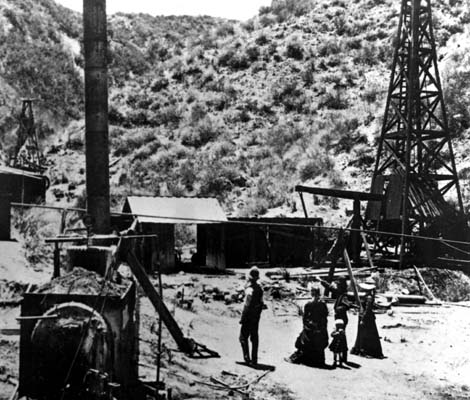
The steam boiler and cable tools, including the “walking beam,” of Pico Well No. 4 in 1877. Photo by Carleton Watkins courtesy Los Angeles Public Library Photo Collection.
Drilling with a steam-powered cable-tool rig in an area known for its many oil seeps, Mentry discovered the Pico Canyon oilfield north of Los Angeles. California’s first truly commercial oil well, the Pico Well No. 4 gusher of September 26, 1876, prompted more development, including pipeline construction and an oil refinery for producing kerosene.

According to an article in the Los Angeles Times, the well initially produced 25 barrels a day from 370 feet. Mentry improvised many of his cable tools, including making a drill stem out of old railroad car axles he welded together.
“The railroad had not then been completed, there was no road into the canyon, water was almost unattainable, and there were no adequate tools or machinery to be had,” noted the Times article.

Charles Mentry, already had successfully drilled 42 wells near Titusville, Pennsylvania, before exploring in the Santa Clara Valley — and launching California’s petroleum industry. Photo courtesy KHTS Radio, Santa Clara.
Mentry persevered and his success in Pico Canyon led to the founding of “Mentryville,” the onetime drilling boom town today site of Stevenson Ranch.
“Although his life was tragically cut short by illness on October 4, 1900, from typhoid fever, Mentry’s legacy as a pioneer in California’s oil industry endures,” noted KHTS Radio, Santa Clara. “His work in Pico Canyon not only made him a key figure in the region’s development but also set the stage for California’s future as an oil-rich state,” KHTS reported in 2025.
Visit the Santa Clarita Valley Historical Society website to learn more Pico Canyon petroleum exploration and production history.
First Refinery
California Star Oil Works deepened the well to 560 feet, increasing daily production by 125 barrels, and constructed its pipeline from Pico Canyon to the newly built refinery in Newhall, just south of Santa Clarita.
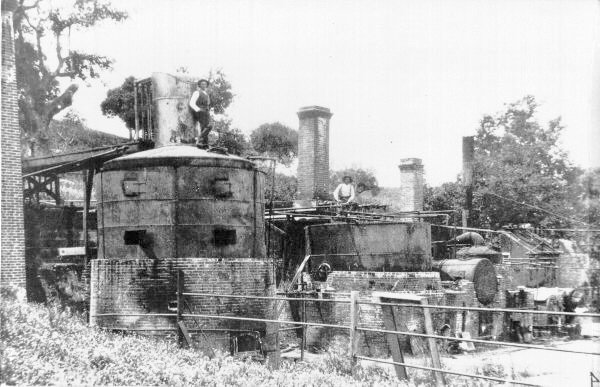
By 1880, California’s first commercial refinery processed oil from its first commercial oil well to make kerosene and other products. Photo courtesy the Santa Clarita Valley Historical Society.
Producing kerosene and lubricants, Newhall’s Pioneer Refinery on Pine Street would become the first successful commercial refinery in the West. Giant stills set on brick foundations included two capable of producing 150 barrels a day each. The city of Santa Clarita received California’s first successful refinery as a gift from Chevron in 1997.
The Santa Clarita refinery, today preserved as a tourist attraction, is among the oldest in the world. The major oil company can trace its beginnings to the 1876 Pico Canyon oil well, which has been designated a historic site by the California Office of Historic Preservation.
Chevron Corporation, once the Standard Oil Company of California, in 1900 acquired Pacific Coast Oil Company. Pacific Coast had become majority owner of California Star Oil Works in 1879.
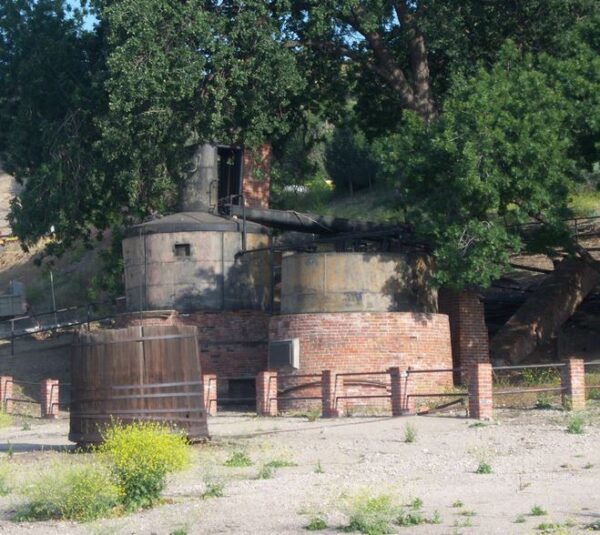
Santa Clarita acquired California’s first refinery as a gift from Chevron in 1997. It is one of the oldest existing oil refinery sites in the world. Photo by Konrad Summers.
Refining Kerosene for Lamps
California’s commercial refineries were among the first in America, where the industry began with small refineries in Pittsburgh, Pennsylvania, producing kerosene for lamps. The oil came from Titusville area oilfields — and a giant 1871 field discovered at Bradford, about 70 miles to the northeast.

The Bradford oilfield, which became known as America’s “first billion-dollar oilfield,” launched many Pennsylvania refineries, including the still-operating American Refining Group. The field’s first well produced just 10 barrels a day from 1,110 feet.
By 1875. Bradford leases reached as high as $1,000 per acre. A decade later, a sudden decline in the oilfield’s production led to a technological breakthrough. Pioneers in the new science of petroleum geology suggested that water pressure on oil sands could be used to increase oil production — “waterflooding” the geologic formation.
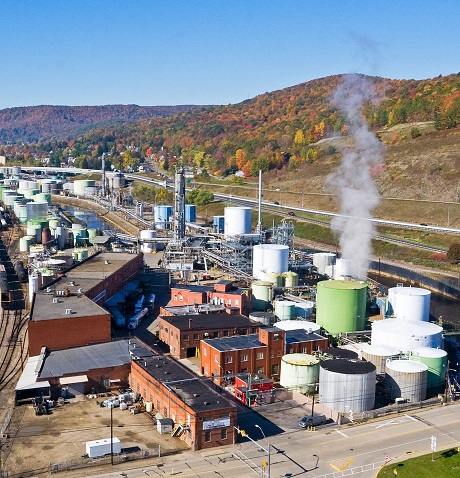
The oldest operating U.S. oil refinery began in 1881 in Bradford, Pennsylvania.
In Neodesha, Kansas, the Norman No. 1 well of 1892 well revealed a petroleum-rich geologic region that would extend across Oklahoma, Texas and Louisiana. Standard Oil built a refinery in Neodesha in 1897 that refined 500 barrels of oil a day. Standard was the first to process oil from the giant Mid-Continent field (learn more in Kansas Well reveals Mid-Continent).
As of January 1, 2022, there were 130 operable petroleum refineries in the United States, according to the Energy Information Administration (EIA), down from 141 refineries in 2017.
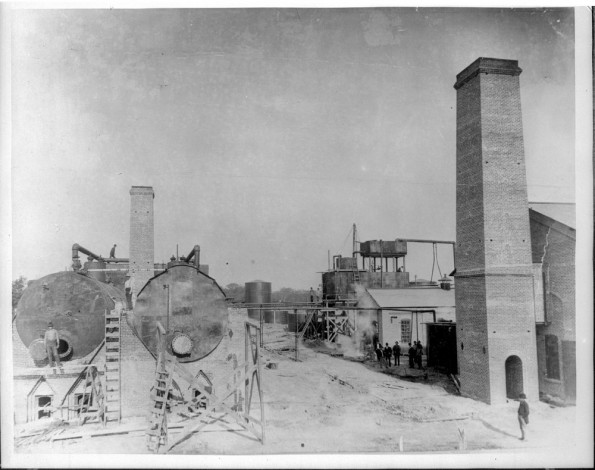
Built in 1897, a Standard Oil refinery in Neodesha, Kansas, refined 500 barrels of oil per day – the first to process oil from the Mid-Continent field. From “Kansas Memory” collection of the Kansas Historical Society.
For an investigation into which California oil well was the first, see this 2011 SearchReSearch blog of Dan Russell.

Learn more California petroleum history in the Signal Hill Oil Boom.
_______________________
Recommended Reading: California State University, Dominguez Hills (2010); Pico Canyon Chronicles: The Story of California’s Pioneer Oil Field
(2010); Pico Canyon Chronicles: The Story of California’s Pioneer Oil Field (1985). Your Amazon purchase benefits the American Oil & Gas Historical Society. As an Amazon Associate, AOGHS earns a commission from qualifying purchases.
(1985). Your Amazon purchase benefits the American Oil & Gas Historical Society. As an Amazon Associate, AOGHS earns a commission from qualifying purchases.
_______________________
The American Oil & Gas Historical Society (AOGHS) preserves U.S. petroleum history. Please become an AOGHS annual supporter and help maintain this energy education website and expand historical research. For more information, contact bawells@aoghs.org. Copyright © 2025 Bruce A. Wells.
Citation Information: Article Title: “First California Oil Well.” Authors: B.A. Wells and K.L. Wells. Website Name: American Oil & Gas Historical Society. URL: https://aoghs.org/petroleum-pioneers/first-california-oil-well. Last Updated: April 10, 2025. Original Published Date: September 9, 2015.




(2000); Images of America: Around Bradford
(1997); The Prize: The Epic Quest for Oil, Money & Power (1991). Your Amazon purchase benefits the American Oil & Gas Historical Society. As an Amazon Associate, AOGHS earns a commission from qualifying purchases.











